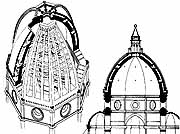
Uffizi - Venus by Botticelli
 Part Two
Part Two
Excusez nous mais cette page n'est pas été encore
traduite en Français
| Selected by StudyWeb One of the Internet's premier sites for educational resources for students and teachers. |
The word Renaissance, used for the first time by Vasari in his book "Vite" (1550), refers to the historic period between the late 14th century and the second half of the 16th century, which was characterized by the rebirth of the cultural and artistic life. This phenomenon involved the whole of Europe but its first roots undoubtedly originate in early Florentine Humanism. Thus the rediscovery of classical studies, seen from a free and lay point of view, made it possible to uphold man and his possibilities of free thought and action through a critical analysis of his world that followed the guide-lines of the old masters. It meant a complete release of thought and action from the strict theological and very limited dogmas of the Middle Ages.

Academy Gallery - Adimari Cassone
Fundamentally, from the philosophical point of view, the Renaissance
meant naturalism, in other words, the study of man and the universe without
the use of metaphysics. Man is the centre and measure of all things,
a chosen creator who echoes the deep harmony between the microcosm and
the macrocosm.
Niccoló Cusano, Marsilio Ficino, Giovanni Pico della Mirandola and Giordano
Bruno re-read Plato and, each one in their own way, found the inspiration to
compare man with his capacity for knowledge (Neoplatonism). Alberti,
Salutati and Vergerio rediscovered the values of human independence and dignity
in the philosophy of the Stoics. Lorenzo Valla, following the ideas of Epicurus,
claimed the end of the principle of authority ("ipse dixit"). Pietro
Pomponazzi, a follower of Aristotle, made his own completely laical interpretation,
denying immortality of the soul and proposing ethics that were free of religious
considerations. Machiavelli supported the separation of politics from morality.
Bernardino Telesio eliminated metaphysics from natural science. Tommaso Campanella
dared propose a "natural religion" and a Utopian protocommunism.

Cupola by Brunelleschi
A similar release from the strict bonds of metaphysics took place in
the world of science and set the basis for the elaboration of mathematical-experimental
methods.
A new category of scientists and engineers was born of whom Leonardo is one of
the finest examples. New sciences like astrology, alchemy and natural magic helped
to reject the old Aristotelian method, founded on pure deduction.
Important progress was made in the astronomic field by Copernicus, Tycho Brahe
and Keplero, opening up the way for Galileo and heliocentrism.
In the field of mechanics, Tartaglia and Benedetti rejected the Aristotelian
idea of motion being a metaphysical absolute.
As for mathematics, the Italian algebraists (e.g. Cardano) were able to resolve
third degree equations, which the Greeks and Arabs had not managed to do, and
freed calculation from all purely dogmatic considerations.
There was rebellion in medicine against the archaistic ideas of Galen and a rebirth
in the study of anatomy and the importance of direct observation.
The new ideas introduced by Petrarch and Boccaccio in literature were continued
by Alberti, Pulci, Boiardo, Lorenzo the Magnificent,
Poliziano, Machiavelli and Guicciardini. The religious vision of life disintegrated
from the divine to human and from the heroic to bourgeois. The trascendent and
providential conception of human events ceased to exist, instead man was seen
to be orphaned of certainty and a free agent in the universe.
